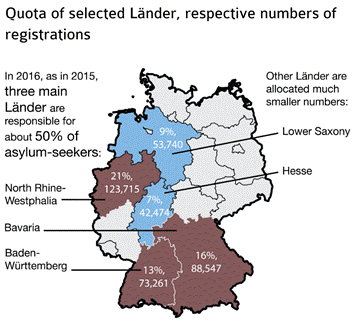-
Who we are
WHO WE AREThe International Organization for Migration (IOM) is part of the United Nations System as the leading inter-governmental organization promoting since 1951 humane and orderly migration for the benefit of all, with 175 member states and a presence in 171 countries.
-
Our Work
Our WorkAs the leading inter-governmental organization promoting since 1951 humane and orderly migration, IOM plays a key role to support the achievement of the 2030 Agenda through different areas of intervention that connect both humanitarian assistance and sustainable development.
What We Do
What We Do
Partnerships
Partnerships
- Where we work
-
Take Action
Take Action
Work with us
Work with us
Get involved
Get involved
- Data and Research
- 2030 Agenda
Migration, Asylum and Refugees in Germany: Understanding the Data
Germany - Last year, Germany was the main European Union (EU) country of destination for migrants and refugees. A new briefing from IOM’s Global Migration Data Analysis Centre in Berlin presents the main data on arrivals of migrants, refugees, and asylum-seekers during 2015.
During 2015, one million registered their intention to seek asylum in Germany. The data shows that since April 2015, the majority of first-time asylum applicants were from Syria. But relatively little is known about the profile of the people who registered an intention to apply for asylum in Germany. This is because Germany´s EASY data collection system only collects data on the country of origin of the applicant and the receiving German “Land” or federal state, and not the socio-economic profile of the person.
In Germany, a quota system is used to distribute refugees and asylum-seekers among German states. This system allocates a specific percentage of asylum applicants, based on tax receipts and population numbers, to each state.
The map below shows the distribution of asylum seekers in Germany, according to the quota system. What is not clear, however, is how many of these people are living in reception centres at any one time. Asylum applicants in Germany are required to stay in a reception facility when they first arrive for up to six months (This was previously three months).

Sources: Die Bundesregierung (2015) http://dipbt.bundestag.de/dip21/btd/18/068/1806860.pdf, p.20; BAMF (2015) http://www.bamf.de/EN/Migration/AsylFluechtlinge/Asylverfahren/Verteilung/verteilung-node.html. Note: “Quota” refers to the acceptance quotas for the individual Federal Länder. These are based on the “Königstein Formula” and assign each Land an individual percentage of asylum-seekers they are obliged to take. The “Königstein Formula” is calculated each year, based on tax receipts and population numbers.
Although high numbers of asylum seekers are expected to continue to arrive in Germany in 2016, forecasting precise figures is difficult for many reasons. For example, it is difficult to predict how the situation in Syria will change.
Nonetheless a continued decline in the numbers of asylum seekers from Albania, Kosovo and Montenegro is anticipated. This is mainly due to the designation of these countries as safe countries of origin in October 2015.
The Head of the Federal Office for Migration and Refugees (BAMF), Frank Jurgen Weise, recently suggested that approximately 500,000 refugees could arrive in Germany in 2016.
BAMF forecasts take into consideration the following factors: developments in countries of origin; information from German institutions dealing with migration issues; the number of asylum applications in Germany; and policy responses to migration across Europe.
Another factor which could affect the inflow of refugees to Germany is the likely number of persons relocated to Germany under the EU´s emergency relocation scheme – which aims to relocate 160,000 people from Greece and Italy to 17 other EU countries. Thus far only 40 people have been relocated to Germany.
What will the economic impact of this huge increase in migration be on Germany? The likely economic effects of migration on the German labour market have been discussed extensively in the German media throughout 2015. Data on this subject are, however, scarce.
A new study conducted by the German Institute for Economic Research (DIW) has highlighted some positive long-term effects. Their calculations suggest that the arrival of so many migrants in Germany will contribute positively to the country´s economic performance, boosting demand for goods and services, and increasing labour supply.
Similarly, the European Commission estimates that the rise in the number of asylum seekers in Europe could have a positive impact on the GDP of EU Member States, increasing it by on average 0.2 to 0.3 per cent by 2017.
The full realization of such economic benefits will depend on the extent to which migrants can be fully integrated into German society in the future.
To read the full Data Briefing, please go to: http://www.iom.int/sites/default/files/country/docs/Germany/Germany-Data-Briefing-1Jan2016.pdf
You can also visit GMDAC’s website www.gmdac.iom.int.
For further information, please contact Frank Laczko at the IOM Global Migration Data Analysis Centre (GMDAC) in Berlin. Tel. +49 30 278 778 11 Email: flaczko@iom.int or gmdac@iom.int